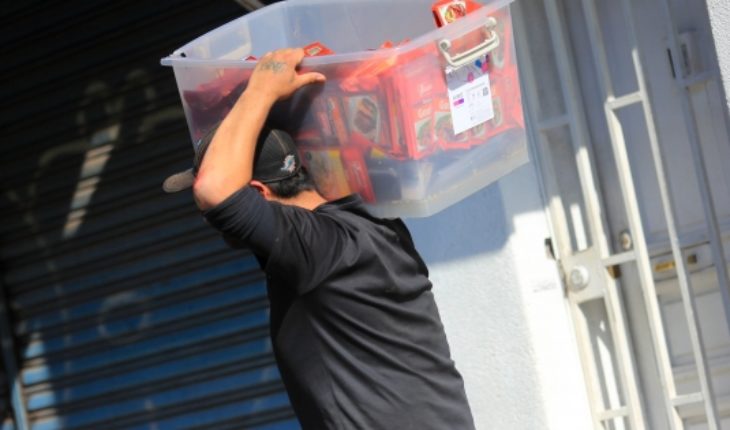In just over a month, Chile appears to have left behind its image of the “great Latin American star”.
The wave of peaceful and violent demonstrations that led this South American country to face the biggest social crisis over the past three decades has left disastrous consequences for its “miraculous” economy.
On Thursday, November 14, before the political agreement to create a new Constitution was announced, the price of the dollar in Chile set a record and surpassed the 800 peso barrier, the highest value in the country’s history.
This marked a hike of close to 12% since the protests began in mid-October.
“It’s a silent earthquake”: the serious economic consequences that the crisis in Chile is having on small and medium-sized enterprises. Since then, the currency has experienced highs and lows, but always maintaining a value well above what is customary, which mainly affects imports of necessities (such as oil) and, therefore, the final price of many Things.
After the social outburst, many industries have been paralyzed.
“This has a direct impact on the economy as the price of many imported consumer goods will be increased,” Mundo Diego Mora, senior executive at consulting firm XTB, tells BBC.
Protesters, who do not march with political party flags, have a long and varied list of social demands ranging from an increase in pensions and minimum wages to profound changes in health and education systems.
In light of recent developments in cities such as Santiago or Valparaiso, where the protests have continued incessantly, none of the measures announced by the government of Sebastián Piñera to deal with the crisis seem to calm the fury of the street.
In this uncertain scenario, the economy is one of the hardest hit. And, in addition to the dollar, there are other numbers that keep Chilean economic authorities on alert.
One of them is the growth of Gross Domestic Product (GDP).
In this regard, both the Ministry of Finance and the Central Bank have slashed the range of their expectations.
For 2019, the government noted that there will be a decline in GDP growth from 2.4%-2.9% to 1.8%-2.2%, while by 2020 the estimate was corrected from a 3-3.5% increase to one between 2%-2.5%.
The Central Bank, meanwhile, published the Economic Expectations Survey (a monthly survey conducted on a group of experts) with unencouraging results and in line with the projections of the Ministry of Finance.
Prior to the social outburst, the body that looks after the stability of the currency had made a GDP growth estimate for 2019 of 2.5%, while now it only reached 1.9%.
Loss of employment
Low growth, meanwhile, can bring devastating consequences for employment, this being one of the factors of greatest concern to the Chilean authorities.
The paralysis of trade, services, tourism and everything to do with “entertainment” – such as the gastronomic field – has been an unexpected economic blow for small and medium-sized enterprises that do not have a large sum of money to finance theself in times of crisis.
The country, some say, is literally working “halfway.”
Since the social outburst on 18 October, the marches have not ceased in Chile.
Many companies have begun firing some of their employees and today it is feared that up to 300,000 jobs could be lost by the end of the year.
Even the president of the Entrepreneurs Association of Latin America, Juan Pablo Swett, has said that if the protests do not stop, up to 500,000 jobs could be at stake.
Against this back, the spectre of economic recession is beginning to gain ground among analysts.
Diego Mora says that” indeed, “there is nervousness in the face of a possible economic recession.” The financial analyst adds that, if two consecutive quarters of GDP fall, the country could enter recessive land in March.
An idea that even the Minister of Finance, Ignacio Briones, has not ruled out.
“I do not want to deceive you, we are going through a delicate economic moment, the economic activity has had a constitable braking (…). Here you don’t have to be a doctor of economics to understand it: when a country operates at half a machine, you can’t expect production, sales, wages, revenue to operate normally,” Briones said on Thursday, November 14.
Economic stalenoly
In conversation with BBC Mundo, José De Gregorio, professor in the Department of Economics at the University of Chile, says that the South American country is experiencing a strong economic paralysis.
“The Chilean economy is in an extremely complex situation, we have a rather massive paralysis of activity. Violence on the streets has not only affected large companies, supermarkets, but also the entire chain that circulates around it. And that’s meant a very significant job drop,” he explains.
In this sense, the former president of the Central Bank and former minister of economy adds that it is not disposable that Chile reaches its highest levels of unemployment since the 1980s, reaching double digits (today it is around 7%).
Taking out various shopping malls has accompanied some of the protests.
“The sharp drop in economic activity coupled with a slow recovery puts us in a very complicated scenario, in which we can end up in some recession and we could spend a full year with negative growth,” he explains.
To this we must add the shadow of uncertainty that has been installed since the outbreak of the crisis, which can have severe consequences on foreign and domestic investment.
“More than 160 minors received pellets, bullets and mistreatment in the Chile protests. It’s unacceptable, regardless of what they’ve done.”
According to a report by the Clapes study center, linked to the Catholic University of Chile, the level of economic uncertainty reached its second-highest historical record (220 points), which means an increase of 94% compared to the same month Past.
“Uncertainty makes people wait, people stop doing what they wanted to do. And that paralyzes many projects,” says De Gregorio.
Thus, as a domino effect, the various factors of the economy of latin America’s so-called “oasis” seem to be fracturing.
And, until the protests stop, it won’t begin its slow recovery.
translated from Spanish: Chile protests: the serious consequences of the social outburst for the country’s economy
November 29, 2019 |





